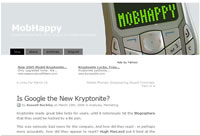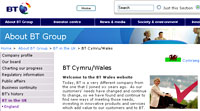 Suppose you ran a Web site, and got a little money in advertising. And then suppose someone came along, and said: “I can give you more readers, and extra advertising!” – would you be grateful? Especially if this was genuine, and tested out? Well, Russell Buckley isn’t grateful.
Suppose you ran a Web site, and got a little money in advertising. And then suppose someone came along, and said: “I can give you more readers, and extra advertising!” – would you be grateful? Especially if this was genuine, and tested out? Well, Russell Buckley isn’t grateful.
His moan sounds silly, but effectively, his gripe is that when Google Mobile take pages for his site and configure them for mobile phone surfers, they take out the adverts, and put their own adverts on. And he’s complained to Google about this, and blogged it, and still, they don’t respond.
He has, nonetheless, a point. His actual argument, when you strip away the egotism of comparing his complaint about Google with the collapse of Kryptonite business, is that Google is actually editing his page, not just formatting it.
 The Kryptonite comparison, summary: inhabitants of the InterWeb Blogland discovered you could steal a bike locked with Kryptonite even if all you had was a ball point pen, and Kryptonite dismissed those quaint Bloglanders as irrelevant. Well, yes; if you sell a product which is shown to be non-functional, you need to deal with the bad press.
The Kryptonite comparison, summary: inhabitants of the InterWeb Blogland discovered you could steal a bike locked with Kryptonite even if all you had was a ball point pen, and Kryptonite dismissed those quaint Bloglanders as irrelevant. Well, yes; if you sell a product which is shown to be non-functional, you need to deal with the bad press.
But the comparison viewed in one way is empty. Google is doing nothing of the sort – its product works, and works as described. It adds extra revenue to the Web site owner’s income stream, and it does it by making a sensible call on how to format pages.
Viewed from another position, you might think that Google should start of listen to the buzz on the blogs (it’s not like they don’t have the tool to find out is it!), in the way that Kryptonite _didn’t_.
That said, Google is arrogating to itself a decision which you’d normally expect the Web site manager to make: what appears on the Web page. And it really ought to have the consent of the site manager to do that. And if it hasn’t, then it should talk.
 Now, I can see Google’s point. “What is this guy’s problem?” you might say. After all, most adverts on Web pages are there without the explicit consent of the site manager. One-click and other advert providers post adverts “on the fly” and track the individual user. Click on one advert for fast cars, and they’ll probably show you more next time you visit; and they don’t ring up the Web site manager and ask specific permission. They just download the advert. (Eventually. When you’re almost out of patience, and thinking of switching to Firefox and running Adblock. Another story…)
Now, I can see Google’s point. “What is this guy’s problem?” you might say. After all, most adverts on Web pages are there without the explicit consent of the site manager. One-click and other advert providers post adverts “on the fly” and track the individual user. Click on one advert for fast cars, and they’ll probably show you more next time you visit; and they don’t ring up the Web site manager and ask specific permission. They just download the advert. (Eventually. When you’re almost out of patience, and thinking of switching to Firefox and running Adblock. Another story…)
What Google is doing is even more sensible. They are saying: “This advert is simply too big to run on a mobile phone. It will cost the phone owner real dosh to download, it won’t render properly, the advertiser will be horrified to see how it looks, and it will hide the actual page content which the subscriber wants to see. We’ll hide it, and show a Google Adsense advert instead.”
And frankly, most of us would say: “Exactly what we want you to do!” – and at the end of the day, the site owner gets a share of the Adsense revenue, from readers who wouldn’t have seen the page otherwise.
But if Russell told Google he didn’t want them to do that. He’s entitled to do so. And he blogged it when they ignored him. And yes, his blog got some traction – in that other bloggers linked to it – and Google still ignored him.
I get the impression his bona fides are not altogether clear, here, because someone who ought to know, has said that Russell has (or has had) an association with a rival outfit – Yahoo. It would be good to hear his response to that – but if true, it’s definitely something he should have disclosed. We’re pleased to say that Russell did get in touch, and we thank him for that. He assures us that he has no connections with Yahoo, and therefore has no axe to grind on this one.
At the end of the day, whatever the rights and wrongs of his approach, and whether he’s exaggerating the influence of his blog and the blogworld, or not, he has a point: Google is being arrogant. It is making decisions which its mobile clients have not asked for, and even, have specifically asked them not to do – and when they complain, it isn’t responding.
It may be small beer to Google, but it’s exactly this “faceless bureaucracy” which is its Achilles heel. Anybody who deals with the company will tell you that getting a real person to respond, is harder than getting a refund out of City Hall; and that the “don’t be evil” motto appears to be one which Google parses according to its own standards, not necessarily those of the rest of us.
 Slimmer than a stick insect with the runs, the new world’s thinnest phone comes in the shape of the EV-K100 handset, an ultra-thin gizmo made by Korean cell phone makers KTF Technologies.
Slimmer than a stick insect with the runs, the new world’s thinnest phone comes in the shape of the EV-K100 handset, an ultra-thin gizmo made by Korean cell phone makers KTF Technologies. “We substantially cut down the thickness of the antenna incorporated into the EV-K100 and instead extended its length to secure all the necessary functions,” said a KTF spokesman.
“We substantially cut down the thickness of the antenna incorporated into the EV-K100 and instead extended its length to secure all the necessary functions,” said a KTF spokesman. The company intend to market the bar-type EV-K100, codenamed “No. 7,” from next week via its parent firm KTF for around 400,000 won ($412).
The company intend to market the bar-type EV-K100, codenamed “No. 7,” from next week via its parent firm KTF for around 400,000 won ($412). Microsoft appear to be trying the doors of the lucrative movie download business for the Xbox360 with the announcement of a video content deal with music label Epic Records.
Microsoft appear to be trying the doors of the lucrative movie download business for the Xbox360 with the announcement of a video content deal with music label Epic Records. Videos and “exclusive artist content” will also be made available for download from the Xbox site.
Videos and “exclusive artist content” will also be made available for download from the Xbox site. Epic has already dished out music videos for the Xbox 360 from the likes of Franz Ferdinand and Audioslave, and their catalogue also includes acts like Shakira, Matisyahu, Jennifer Lopez and Antipodean dandruff shakers, AC/DC.
Epic has already dished out music videos for the Xbox 360 from the likes of Franz Ferdinand and Audioslave, and their catalogue also includes acts like Shakira, Matisyahu, Jennifer Lopez and Antipodean dandruff shakers, AC/DC. WorldMate 2006 Professional Edition v4.1
WorldMate 2006 Professional Edition v4.1 Travellers can get real-time information about their flights – including the inevitable delays, gate and terminal information – with global forecasts letting them know whether to pack the Goretex or the suntan lotion.
Travellers can get real-time information about their flights – including the inevitable delays, gate and terminal information – with global forecasts letting them know whether to pack the Goretex or the suntan lotion. Essentially the same program minus the live flight and subscription services, this is an essential Pocket PC installation even for occasional travellers, with the updating weather and currency converters almost worth the price alone.
Essentially the same program minus the live flight and subscription services, this is an essential Pocket PC installation even for occasional travellers, with the updating weather and currency converters almost worth the price alone. These minor quibbles aside, both programs offer a compelling suite of utilities for travel and come highly recommended for perambulating Pocket PC users.
These minor quibbles aside, both programs offer a compelling suite of utilities for travel and come highly recommended for perambulating Pocket PC users. You’ll probably remember that we broke the story back in September about the
You’ll probably remember that we broke the story back in September about the  BT’s also confirming that the box that will do all of these things is to be call the BT Hub. Its will use a software platform powered by Microsoft and that the set-top box is to be made by Philips.
BT’s also confirming that the box that will do all of these things is to be call the BT Hub. Its will use a software platform powered by Microsoft and that the set-top box is to be made by Philips. Suppose you ran a Web site, and got a little money in advertising. And then suppose someone came along, and said: “I can give you more readers, and extra advertising!” – would you be grateful? Especially if this was genuine, and tested out? Well,
Suppose you ran a Web site, and got a little money in advertising. And then suppose someone came along, and said: “I can give you more readers, and extra advertising!” – would you be grateful? Especially if this was genuine, and tested out? Well,  The Kryptonite comparison, summary: inhabitants of the InterWeb Blogland discovered you could steal a bike locked with Kryptonite even if all you had was a ball point pen, and Kryptonite dismissed those quaint Bloglanders as irrelevant. Well, yes; if you sell a product which is shown to be non-functional, you need to deal with the bad press.
The Kryptonite comparison, summary: inhabitants of the InterWeb Blogland discovered you could steal a bike locked with Kryptonite even if all you had was a ball point pen, and Kryptonite dismissed those quaint Bloglanders as irrelevant. Well, yes; if you sell a product which is shown to be non-functional, you need to deal with the bad press. Now, I can see Google’s point. “What is this guy’s problem?” you might say. After all, most adverts on Web pages are there without the explicit consent of the site manager. One-click and other advert providers post adverts “on the fly” and track the individual user. Click on one advert for fast cars, and they’ll probably show you more next time you visit; and they don’t ring up the Web site manager and ask specific permission. They just download the advert. (Eventually. When you’re almost out of patience, and thinking of switching to Firefox and running Adblock. Another story…)
Now, I can see Google’s point. “What is this guy’s problem?” you might say. After all, most adverts on Web pages are there without the explicit consent of the site manager. One-click and other advert providers post adverts “on the fly” and track the individual user. Click on one advert for fast cars, and they’ll probably show you more next time you visit; and they don’t ring up the Web site manager and ask specific permission. They just download the advert. (Eventually. When you’re almost out of patience, and thinking of switching to Firefox and running Adblock. Another story…) Voice over Internet Protocol (VoIP) is slowly but steadily creeping into American homes, with adoption up 20% since June 2005, and growing user satisfaction.
Voice over Internet Protocol (VoIP) is slowly but steadily creeping into American homes, with adoption up 20% since June 2005, and growing user satisfaction. Only way is up
Only way is up Early adopters to VoIP may recall the experience being akin to talking to a stuttering Dalek in an echo chamber, but the research revealed that 67 percent of VoIP users believe voice quality is now equal to traditional landline services, with 19 percent reckoning that internet calls sound better than those on wired phones lines.
Early adopters to VoIP may recall the experience being akin to talking to a stuttering Dalek in an echo chamber, but the research revealed that 67 percent of VoIP users believe voice quality is now equal to traditional landline services, with 19 percent reckoning that internet calls sound better than those on wired phones lines. Making blogging too easy seems to be making it hard. It may be coincidence, but one example of “too easy” blogging is the spam blog, or splog – and suddenly, there’s a rash of upset bloggers who have had their blogs blacked.
Making blogging too easy seems to be making it hard. It may be coincidence, but one example of “too easy” blogging is the spam blog, or splog – and suddenly, there’s a rash of upset bloggers who have had their blogs blacked. And a spam blog is something that doesn’t actually have any real content. It’s just links to trackback pointers for everybody else. The trouble is, all the signs of a spam blog are caused by the ease with which they are built. You just have to create the blog (two clicks) and then set up a robot that scours the web for new posts, and links to the trackbacks.
And a spam blog is something that doesn’t actually have any real content. It’s just links to trackback pointers for everybody else. The trouble is, all the signs of a spam blog are caused by the ease with which they are built. You just have to create the blog (two clicks) and then set up a robot that scours the web for new posts, and links to the trackbacks. I’m not saying that Qumana is what caused the blog to be blacked. I am saying that if it produces a series of random, unrelated tags to a single site, it’s going to fulfil one of the prime indicators of a splog. And when random, unrelated blog entries all get tagged “Qumana” whatever their subject, you have something so similar, it’s going to be quite hard to see what a blog provider can do to filter it.
I’m not saying that Qumana is what caused the blog to be blacked. I am saying that if it produces a series of random, unrelated tags to a single site, it’s going to fulfil one of the prime indicators of a splog. And when random, unrelated blog entries all get tagged “Qumana” whatever their subject, you have something so similar, it’s going to be quite hard to see what a blog provider can do to filter it. The Welsh Assembly has announced today that they’ve selected the BT Group to provide the broadband infrastructure for the remaining exchange areas in Wales.
The Welsh Assembly has announced today that they’ve selected the BT Group to provide the broadband infrastructure for the remaining exchange areas in Wales. Once completed, virtually every single household in Wales will be able to join in with the broadband revolution and get stuck into video conferencing, Voice over Internet Protocol (VOIP) and other business and entertainment uses.
Once completed, virtually every single household in Wales will be able to join in with the broadband revolution and get stuck into video conferencing, Voice over Internet Protocol (VOIP) and other business and entertainment uses. Compared to some other European countries, Wales’ achievement is significant; in Ireland, for example, only about 18.0% of the population have broadband connections.
Compared to some other European countries, Wales’ achievement is significant; in Ireland, for example, only about 18.0% of the population have broadband connections.